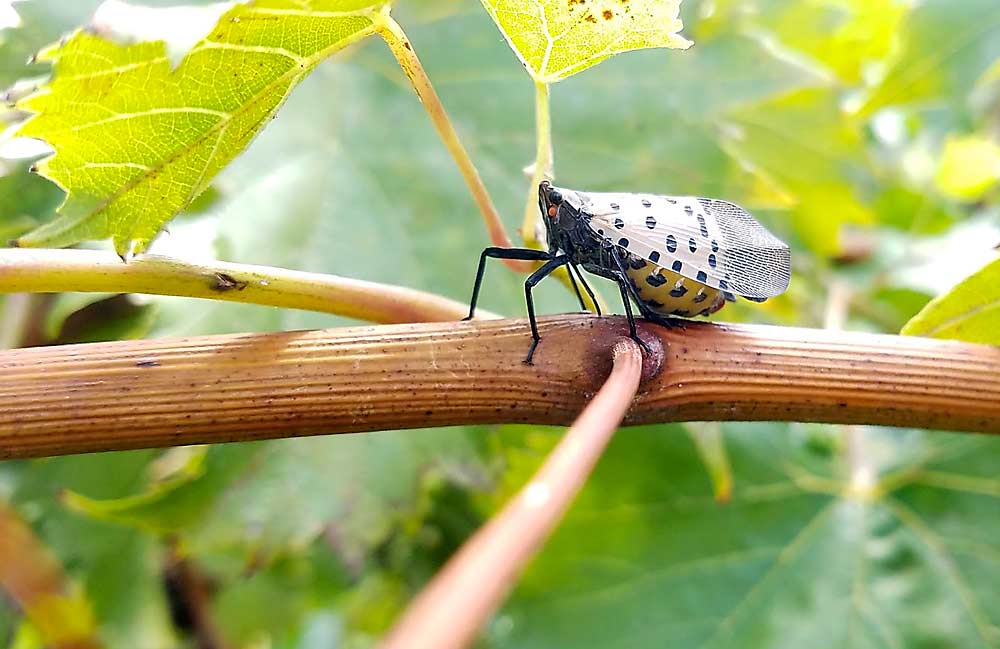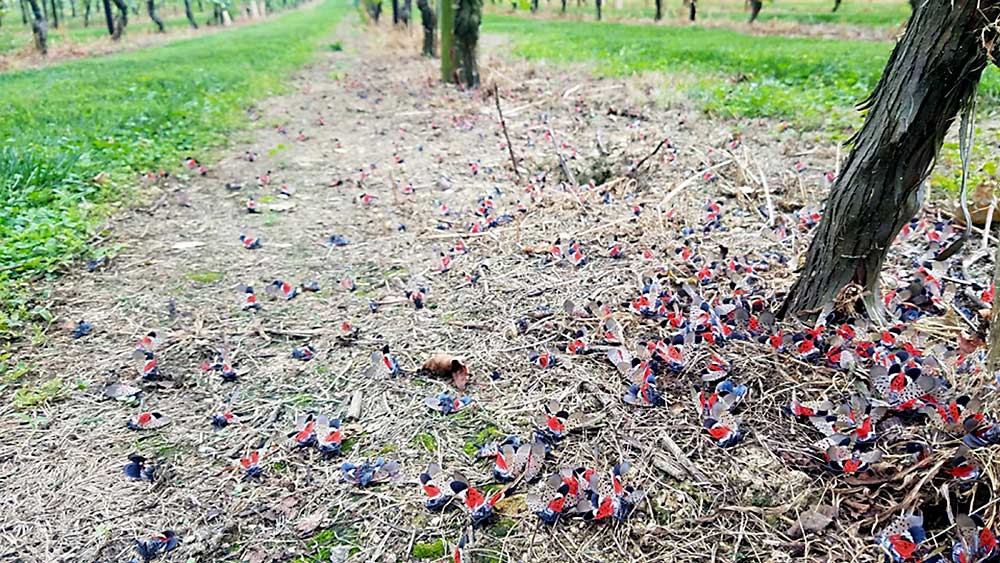
The spotted lanternfly, a planthopper that has already caused significant damage to vineyards in Pennsylvania, is spreading beyond that state. Already established in six states and detected in an additional four, it likely will keep spreading, and grape growers across the country must be prepared.

Heather Leach discussed the invasive pest in December, during the Great Lakes Fruit, Vegetable & Farm Market EXPO in Grand Rapids, Michigan. Leach, an extension associate with Penn State University, was hired in May 2018 to deal exclusively with the spotted lanternfly (SLF). Her work is part of a four-year, $7.3 million grant from the U.S. Department of Agriculture and connects with research in other states.
Native to Asia, SLF was first discovered in Eastern Pennsylvania in 2014. It’s a “great hitchhiker” with a “broad host range” of more than 70 plants, Leach said.
Unfortunately, grapes are one of its favorite hosts. SLF has caused such “scary, significant” damage to dozens of grape growers in Eastern Pennsylvania — feeding swarms of SLF can kill entire vineyards — that the state set up a quarantine zone encompassing 14 counties, she said.
“A lot of growers are postponing planning,” Leach said. “They’re not going to consider the future of their farm until they get spotted lanternfly under control.”
David Biddinger, a research entomologist with Penn State, said SLF is the worst grape pest he’s seen in the Eastern U.S. since phylloxera. Other pests only damage the fruit, but SLF can kill the vines themselves over a season or two.
“Not many pests, other than phylloxera, threaten the life of the vine as does SLF,” he said. “At least with phylloxera there are resistant rootstocks to help mitigate the problem, but with SLF we have not seen any varietal differences.”
Like the brown marmorated stink bug, SLF spends most of its life cycle outside of the fruit crop, building up its population in the surrounding landscapes all summer, then descending in “huge numbers” to feed, Biddinger said.
SLF will linger at the edge of vineyards until August or so, when adults will move in and start feeding on shoots, followed by trunks later in the season. SLF feeding stresses the vines — reducing photosynthesis, transpiration, carbon assimilation, Brix and cold hardiness — and might eventually kill them. Populations peak in mid- to late September. Adults are most active in afternoons and evenings, Leach said.
Anne Nielsen, an extension specialist with Rutgers University, said SLF is starting to become a problem in northern New Jersey. Populations have been found in multiple vineyards, and a couple of growers have had to apply insecticides. State growers are on the alert for the pest and are building off of the management recommendations that have been developed by Penn State.
Other states with known spotted lanternfly infestations include Delaware, Maryland, Virginia and West Virginia. Four additional states — New York, Connecticut, Massachusetts and North Carolina — have detected SLF within their borders. Growers are urged to report SLF sightings to their state agriculture departments.

Management
Growers in Eastern Pennsylvania predominantly rely on insecticides to control SLF, but that’s not a foolproof solution. SLF is easy to kill with insecticides, but there are so many in the surrounding landscapes that as soon as the spraying is over, the bugs reinvade in massive numbers. The number of insecticide applications over a grower’s season increased by 10 between 2016 and 2018, and the cost rose from $54 per acre to $147 per acre for product alone, according to Leach.
Growers have tried other methods — removing tree of heaven, another favored host, or using it as a “trap tree” for spraying; removing egg masses in winter (not much use if your neighbor isn’t doing it); removing tall trees near vineyards (SLF likes to enter vineyards from tall points) — but none of them work as well as insecticides, she said.
The most common insecticides used against SLF in vineyards are dinotefuran (Scorpion, Venom), bifenthrin (Brigade, Bifenture), acetamiprid (Assail), zeta cypermethrin (Mustang Maxx), carbaryl (Sevin), and malathion. When pressure is at its worst, from August to October, growers should spray every two to three days and spray later in the day, when the bugs are most active, Leach said.
Growers who expect high SLF populations in their vineyards could use long-residual products (particularly thiamethoxam and bifenthrin) with longer preharvest intervals (PHIs) in August. Closer to harvest, compounds with short PHIs should be used. These products often have reduced residual activity and will require repeated applications for adequate control. Even though SLF has only one generation per year, rotate insecticide classes/modes of action throughout the season to reduce the likelihood of resistance — not just for SLF but other pests as well, Leach said.
“We have also tested organic and biorational products, but they tend to be more expensive and to give much shorter residual control of SLF,” Biddinger said.
The researchers are working with various pesticide companies to add SLF to the labels of the more effective products and to increase the lower application rates used for other grape pests that are much less effective on SLF, Biddinger said.
In the long term, researchers hope effective biocontrols could replace intensive reliance on insecticides. There’s also research underway to evaluate two potential biocontrol agents that evolved with SLF in Asia, as well as intriguing signs that the gypsy moth egg parasitoid wasp —introduced to the U.S. over a century ago — will also target SLF eggs. In another insight from gypsy moth research, scientists at Cornell University are testing fungal pathogens as another potential biocontrol, according to the New York State Integrated Pest Management program.
—by Matt Milkovich
Related:
—Spotted lanternfly a new grape threat
—Good to Know: Spotted lanternfly risk regions mapped






Tips for killing spotted lanternflies: https://colinpurrington.com/2020/02/spotted-lanternfly-control-tips/.